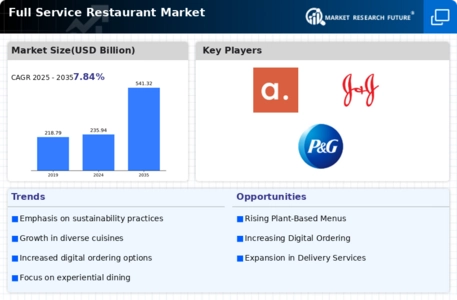Health and Wellness Trends
The Full Service Restaurant Market is increasingly influenced by health and wellness trends, as consumers become more health-conscious. There is a growing demand for menu items that cater to dietary restrictions, such as gluten-free, vegan, and organic options. Recent statistics indicate that nearly 40 percent of consumers actively seek out healthier dining choices when eating out. This shift is compelling full service restaurants to revamp their offerings, focusing on fresh, locally sourced ingredients and transparent nutritional information. By aligning with these health trends, restaurants can not only meet consumer expectations but also enhance their brand reputation within the Full Service Restaurant Market.
Sustainability and Ethical Practices
Sustainability and ethical practices are becoming paramount in the Full Service Restaurant Market, as consumers increasingly prioritize environmentally friendly dining options. There is a growing expectation for restaurants to adopt sustainable sourcing practices, reduce food waste, and implement eco-friendly operations. Recent surveys reveal that over 70 percent of diners are willing to pay more for meals prepared with sustainable ingredients. This shift is prompting full service restaurants to not only enhance their sustainability efforts but also communicate these practices effectively to their customers. By aligning with these values, restaurants can strengthen their brand image and appeal to a conscientious consumer base within the Full Service Restaurant Market.
Technological Advancements in Dining
Technological advancements are reshaping the Full Service Restaurant Market, as establishments increasingly adopt innovative solutions to enhance customer experience. The integration of mobile ordering, contactless payments, and digital menus is becoming commonplace. Data suggests that restaurants utilizing technology to streamline operations can improve efficiency by up to 30 percent. Furthermore, the use of data analytics allows restaurants to better understand customer preferences, enabling personalized marketing strategies. As technology continues to evolve, full service restaurants that embrace these advancements are likely to gain a competitive advantage, positioning themselves favorably within the Full Service Restaurant Market.
Growing Popularity of Experiential Dining
The Full Service Restaurant Market is witnessing a surge in the popularity of experiential dining, where the overall experience transcends the mere act of eating. Consumers are increasingly seeking out restaurants that offer unique atmospheres, interactive dining experiences, and themed events. This trend is reflected in the rise of pop-up restaurants and immersive dining concepts, which cater to the desire for memorable experiences. Research indicates that establishments focusing on experiential elements can see an increase in customer loyalty and repeat visits. Consequently, full service restaurants that prioritize creating engaging environments are likely to thrive in the competitive landscape of the Full Service Restaurant Market.
Rising Consumer Demand for Diverse Cuisines
The Full Service Restaurant Market is currently experiencing a notable increase in consumer demand for diverse and unique culinary experiences. This trend is driven by a growing interest in global cuisines, as consumers seek to explore flavors from different cultures. According to recent data, approximately 60 percent of diners express a preference for restaurants that offer international dishes. This shift in consumer preferences is prompting full service restaurants to innovate their menus, incorporating a variety of ethnic foods and fusion dishes. As a result, establishments that adapt to these changing tastes are likely to attract a broader customer base, enhancing their competitive edge in the Full Service Restaurant Market.

















Leave a Comment